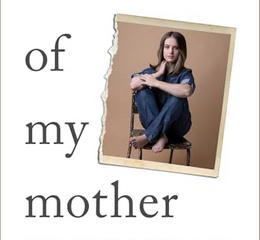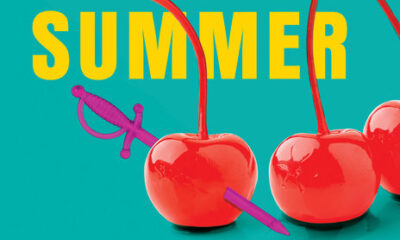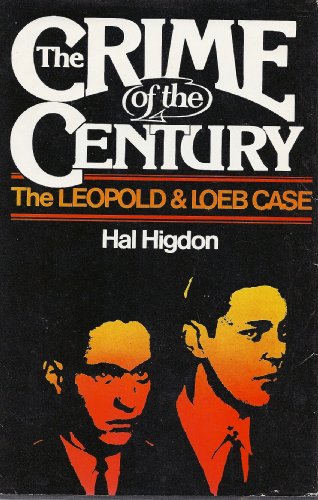
True Crime Studies: Leopold & Loeb and the Crime of the Century
More Videos
Published
4 years agoon
By
Rachel RothFamous, or rather infamous, for a number of reasons. Nietzsche fanboys spoiled rotten since birth and twisted lovers, they were pretentious little brats that murdered a 14-year-old boy out of sheer boredom. Nathan Leopold Jr. and Richard Loeb, two young Chicago men who introduced the world to “thrill killings.” The ’20s really were a roaring decade.
Leopold & Loeb: The Crime of the Century by Hal Higdon is probably the most informative book you’ll ever find on the topic. Among the thousands of true crime books published since Leopold and Loeb’s reign of fame, a very small percentage are actually about them. The murder of Bobby Franks is extremely well documented as are the court proceedings that followed. Just about every minor detail about the case are easily available to anyone interested with Hidgon’s book being the official textbook on the subject. Leopold & Loeb: The Crime of the Century is a heavily researched, 380-paged true crime document that you’ll come away from feeling like an absolute expert on all things Leopold and Loeb.
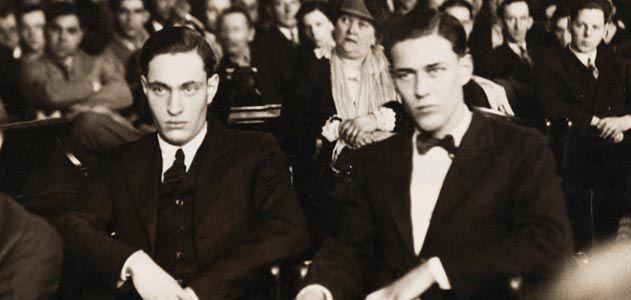
Some true crime books format themselves like novels where the events unfold in an actual narrative, and others are a strictly factual listing of periodic events. This one follows the latter. The bulk of it reads like an extended Wikipedia page where it’s a mixture of actual dialogue and peers/eye-witnesses/investigators recounting everything they know, which is a lot. As I said, both they and their crime are well documented because their one victim was found with relative ease and their confession was offered up on a silver platter. They gave everything up just to brag about it, describing each detail of their ridiculously complicated master plan with excitement burning in their eyes.
Here’s a simplified breakdown:
- Kidnap and kill the chosen victim (Franks was picked at the last minute), must be rich enough to warrant sending the family a ransom note.
- Send ransom note demanding $10,000
- Call family and demand the father, or head of household, to wait for a cab that will drive to a drugstore where further instructions would be waiting.
- Instructions will say to go to the train station where they’re to look in the telegraph box
- Inside would be a note instructing them to board the train and throw the money off the last carriage.
- Leopold and Loeb, watching from afar, would go fetch it later.
The plan might as well have come out of a Perry Mason episode. You just know one of them was masturbating while reading it over in their little bedrooms. The many steps in the plan were on account of them trying to make it clever. Whether or not they got the money was never a concern.
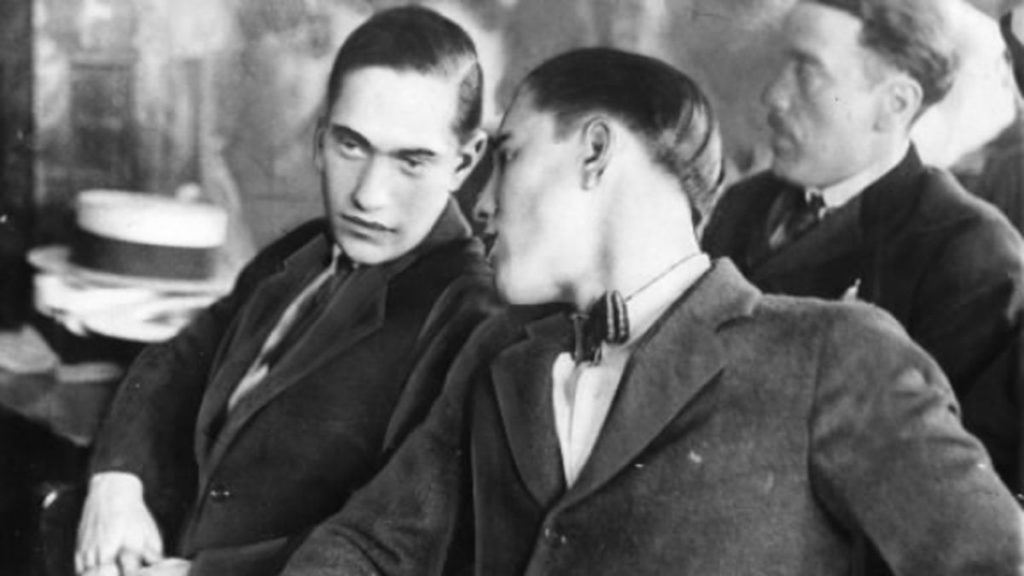
It all starts in 1923, with a robbery at the Zeta Beta Tau fraternity house. Two masked figures familiar with the layout break-in and steal whatever they can fit in their pockets: money, pencils, a pin, a watch, a knife, metals and pens. The only thing they worked at carrying out was an Underwood typewriter. About a year later, that same typewriter would be used to write a ransom note sent to the family of Bobby Franks, after the boy’s body was already dumped in a culvert north of Wolf Lake.
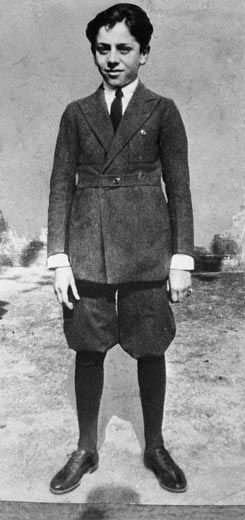
In 1924, Bobby Franks willingly got into a car in broad daylight and was bludgeoned to death. His body was found on May 22, 1924, and the half-assed manhunt began. Bobby had suffered blunt force trauma to the head but apparently died from asphyxiation. Suffocated from either a gag or from being stuffed in the culvert. In an attempt to obscure his identity, hydrochloric acid was poured on his face and genitals to disguise the fact that he had been circumcised, or rather to hide that he was Jewish but all that did was start a rumor of molestation. Many schoolteachers were targeted and accused of pedophilia.
Despite the large gaps in police intelligence, it didn’t take that long for them to track the murder back to Leopold and Loeb. The smoking gun that led police to their door was a pair of bird-watching spectacles Leopold dropped near Wolf Lake and the font and print pattern of the ransom note which matched the stolen typewriter taken from Richard Loeb’s former fraternity house, Zeta Beta Tau. It took about a week to trace the crime back to them.
“We decided to pick the most likely-looking subject that came our way.” Richard Loeb commented in his version: “The plan was broached by Nathan Leopold, who suggested that as a means of having a great deal of excitement, together with getting quite a sum of money.”
Leopold and Loeb
There are three chief reasons why Nathan Leopold and Richard Loeb have lived on in true crime history so prominently and it’s because they were rich young men, their actions were the first time most people ever heard of murder without a proper motive, and they were in a romantic relationship. Though “romantic” is a bit of a stretch. They were in a weird Natural Born Killers type of relationship built off loneliness and co-dependency.
Higdon studies the relationship between them from a distance whilst looking at it from under a microscope. It’s their relationship that makes this story so engaging and it’s also about 50% of the book’s focus.
“Leopold considered himself inferior to Loeb, but Loeb considered himself inferior to Leopold.”
Honestly, every page that features real dialogue between the boys, paired with personal accounts of their behavior, makes them sound like an old married couple. The two openly admitted to planning the other’s death only to immediately change their minds because…who else would they hang out with?
The Crime of the Century points out the gay panic that ruled a lot of young men during that time, murderers included. Upon capture, Loeb was especially reluctant to be labeled a homosexual. He and Leopold were apparently having “sexual liaisons”, as the book calls them, since 1921. But according to Loeb, their “liaisons” were just part of a business agreement where he would offer sex to Leopold in exchange for partnership in crime. Two things contradict this claim: Loeb implied to vague sexual encounters with other men prior to this and their agreement was set up in 1923, two years after their “liaisons” supposedly began.
There was also a whole master/slave fantasy going on, not as sexual as it sounds, between them which would take up too much time to discuss in full so here’s a link to some info on that.
“The alienist felt that the Franks homicide could be understood only by examining the interplay of these two personalities as they related to each other. ‘Dickie needed an audience. In his fantasies, the criminalistic gang was his audience. In reality, Babe [Leopold] was his audience.'”
“Leopold needed Loeb to compliment him and serve his alter ego.”
One can easily say that the murder was a direct result of their relationship. Not only the assumption that they wouldn’t have killed if they never met, but their reason for killing Bobby Franks was directed at one another.
A good film to watch for the Leopold and Loeb relationship is Barbet Schroeder’s Murder by Numbers from 2002. The film goes off track from the actual crime and doesn’t follow any sort of historical accuracy but the relationship between the two boys is more on the mark than in Compulsion, Swoon, and Rope. I can assume that screenwriter Tony Gayton actually read this book before penning Murder by Numbers, only to merge it with a random Sandra Bullock cop drama, which is what ruined it.

The Hearing
A lot of Leopold & Loeb: The Crime of the Century is dedicated to the hearing. Quick correction, this case is often referred to as the “trial of the century” but it’s not actually a trial because there was no jury, making it a hearing. Leopold and Loeb pleaded guilty so the question of their guilt was already confirmed.
The hearing was about their punishment, whether or not they should get the death penalty. The famed lawyer Clarence Darrow, a fervent opposer of capital punishment, defended them in what would become his most famous case. This part of the book is long, and as someone who hates all things related to court, boring. There are at least two chapters dedicated solely to their psych evaluations, most of which are dated because psychology was still new and many illnesses were incapable of a proper diagnosis.
As I mentioned above, a good film to see Leopold and Loeb’s dynamic is Murder by Numbers, but if you’re interested in the hearing and Darrow, then I recommend Compulsion from 1959. It’s a somewhat accurate portrayal of the hearing and features a good enough replica of Darrow’s famous closing argument.
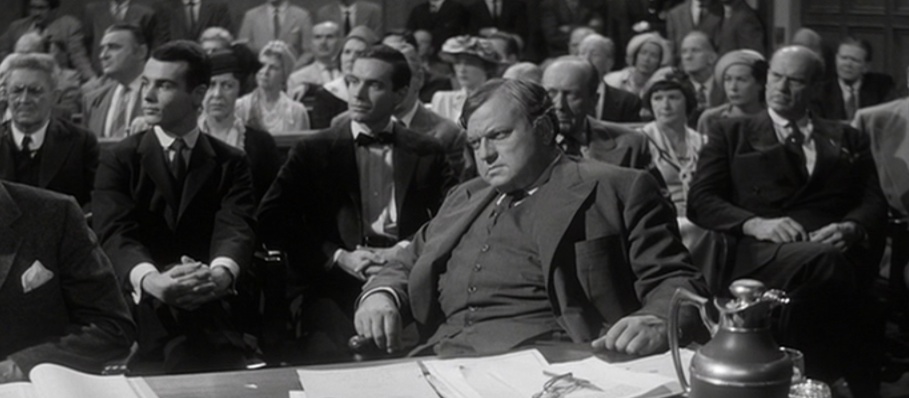
Verdict
There is a lot of information given in this book. You can tell that many years went into the research of it. Unfortunately, it doesn’t off much of anything new but only expands upon on facts that are already widely available. Everything mentioned in The Crime of the Century, I had already heard in some form although the book does develop the case more and fills in some of the blanks.
One of the most interesting sections of The Crime of the Century takes place in Part 3: “Nothing but the Night.” The section is set during their time in prison, they went to the same prison, and shows how incarcerated life has affected them.
 (3.5 / 5)
(3.5 / 5)
Related posts:
- True Crime Studies: The Ardlamont Mystery
- True Crime Studies: “A Bird in Your Hand” is probably the borest true crime book I’ve ever read
- True Crime Studies: Another side of Ted Bundy is shown in Elizabeth Kendall’s ‘The Phantom Prince.’
- True Crime Studies: A Serial Killer in His Own Words by H.H. Holmes
Rachel Roth is a writer who lives in South Florida. She has a degree in Writing Studies and a Certificate in Creative Writing, her work has appeared in several literary journals and anthologies. @WinterGreenRoth

Book Reviews
The Hotel: We’ll All Be There Soon.
Published
2 weeks agoon
March 17, 2025By
C M ReidDaisy Johnson’s, The Hotel is a collection of stories that tell the tale of a hotel built on cursed land. Originally written and recorded as a series for BBC Radio 4 in 2020, (you can find the recordings here https://www.bbc.co.uk/programmes/m000mrcg/episodes/player )
The fourteen-story collection was released in hardcover in 2021. Johnson’s prose is haunting, weaving together the stories of generations of families who have been tempted, forced, or serendipitously dumped at The Hotel. Most leave the message, “I’ll be there soon,” and many disappear from room 63.
- ‘The British literary heir to Stephen King’ Johanna Thomas-Corr, Sunday TimesA triumph of contemporary horror from the Booker Prize-shortlisted author, this collection of short stories will haunt you long after you turn the final pageA place of myths, rumours and secrets, The Hotel looms over the dark Fens, tall and grey in its Gothic splendour
- Built on cursed land, a history of violent death suffuses its very foundations –yet it has a magnetism that is impossible to ignore
- On entering The Hotel, different people react in different ways
Last update on 2025-03-17 / Affiliate links / Images from Amazon Product Advertising API
The Plot.
The Hotel tells the stories of the people who are drawn to The Hotel, or, more accurately, the ground the hotel is built on. The first story explains what we know about the hotel, its tendencies, moods, and … hobbies. We are then introduced to Mary Southgraves, ‘The Witch’, who comes to live with her husband on the land on which The Hotel will be built. The villagers in the pond drown her for predicting a sickness that takes the village children, (no this is not a spoiler she tells you she dies on the first page of her chapter.)
The proceeding chapters build upon this story. We meet the workers who are brought in to fill the pond to begin construction. A child of a guest in 1968 who meets another girl who may or may not actually be there. A maid who takes part in séances and Ouija board sessions. The stories progress through time into the present.
Highlights.
The haunting prose of The Hotel does the majority of the heavy lifting for this collection, which makes sense since it began as a podcast series. Johnson’s prose leans towards poetry, albeit more Poe than Keats.
The repetition of specific characters and family names throughout the different stories was intriguing, giving the stories links. These links trigger a sense of recognition for the reader. There is also a sense of anticipation, knowing what has happened to these families already, we wonder how much more they can withstand. The Hotel is like a curse following these families, but I think Johnson is commenting on lineage and the consequences of past actions. The sins of the father and all that.
- Fifteen highly original and darkly unsettling supernatural stories, performed by some of Britain’s finest actresses ‘This is what we know about The Hotel
- It is bigger on the inside than on the outside
- Do not go into Room 63
Last update on 2025-03-17 / Affiliate links / Images from Amazon Product Advertising API
Drawbacks.
These stories can get confusing at times and I think this is due to the briefness of the stories. It’s hard to keep track of a character that you have spent four pages with and remember them three stories later. I found myself having to stop and turn back to check if that person was who I thought they were. This pausing to turn back interrupts the reading experience. It pulls you out of the story and destroys the atmosphere that Johnson has worked to create.
The Final Take.
The Hotel was an interesting read. Johnson is a talented writer who has published a collection of linked stories that will keep the reader turning pages if only to find out the final fate of these families. That being said, it is obvious that the stories were initially written for a podcast. I’m not sure if it’s the way they are put together or… I don’t know, there’s just something ‘podcasty’ about them. As such I would recommend listening to the audio episodes (see the link above) over reading the book.
 (3 / 5)
(3 / 5)
On Halloween in 2016 Josh Malerman, author of Bird Box, released A House At The Bottom Of A Lake (gosh this is a hefty title!). Last week, I picked this slim book up off my library’s Adult Horror shelves, not knowing what to expect. What I got was a novella that should have been shelved in the teen lit section. Perhaps it is the rather weird underwater sex scene that precludes it from those shelves.
- From the New York Times bestselling author of Bird Box and Malorie comes a haunting tale of love and mystery, as the date of a lifetime becomes a maddening exploration of the depths of the heart
- “Malerman expertly conjures a fairy tale nostalgia of first love, and we follow along, all too willingly, ignoring the warning signs even as the fear takes hold
- ”—Lit Reactor The story begins: young lovers, anxious to connect, agree to a first date, thinking outside of the box
Last update on 2025-03-10 / Affiliate links / Images from Amazon Product Advertising API
The Plot.
When James asks Amelia out on a date during summer break, canoeing was the last thing that she expected. Borrowing his uncles canoe, James hopes he can show Amelia an exciting time, because he really likes this girl! The date starts well and the conversation, if stilted at times, is banter-ey and cool.
They head out on the first lake, but James has an idea that they might have a better time on the lake that joins to this one. It is quieter, no speed boats to show him up, they’ll be able to eat their picnic lunch in peace and quiet. When they arrive, though, they notice a tunnel, that may lead to a third lake. Eager to show Amelia that he is an exciting kind of guy, James heads through the tunnel.
Lo and behold, it is another lake! Albeit, a bit murky and deserted, but that’s alright. That is until they notice that beneath the bow of the boat is a tiled roof. Beneath that tiled roof is a whole house. What ensues is a summer of falling in love and exploring a sunken house that may not be as empty as they thought.
Highlights.
Malerman writing the internal monologue of an angsty seventeen-year-old on a first date is one of the most authentic things I’ve read for a long time. Even down to James worrying about revealing that his dad owns the hardware shop he works in. Scared that Amelia will think that is all he is going to do with his life.
The ending (which of course I cannot discuss here) was well done, although a little contrived and predictable. It felt as if it had been almost tacked on the end as an afterthought. Perhaps Malerman finished the story without the final chapter, but was encouraged to add that last bit to give readers some closure
- “A book that demands to be read in a single sitting, and through the cracks between one’s fingers
- There has never been a horror story quite like this
- Josh Malerman truly delivers
Last update on 2025-03-10 / Affiliate links / Images from Amazon Product Advertising API
Drawbacks.
Malerman is a good writer, we have seen this in the many novels he has released since Bird Box. A House At The Bottom Of A Lake did not meet the usual standard. There are many reasons I say this. The first is a lack of creativity in descriptive passages in this book. They all felt pretty drab and began to become repetitive by the end of the story. I don’t know how many, times Malerman compared the way that James and Amelia were moving under the water in their scuba suits as ‘Astronaut-like’ or ‘Astronaut-esque’ or ‘ Like he was walking without gravity’, but really can you find another comparison please because this one is all used up!
As I mentioned in the intro, this did feel like a YA novel. Not only because both of the main characters are seventeen, but the prose is a too simple to be engaging. A House A The Bottom Of A Lake might be marketed differently in Australia (where this humble reviewer lives), perhaps making it to the YA shelves in the US or UK, but this is definitely not adult horror.
The Final Take.
Josh Malerman is a favorite of mine. I tend to pick up his books, blurb unread, because I will generally enjoy what he is putting out there. The exception to this rule is A House At The Bottom Of A Lake (if I never have to type that title again I will be pleased!). It just didn’t hit the way his other novels have and I was disappointed.
 (2 / 5)
(2 / 5)
Imagine this. You’re home alone, waiting for your partner to return, when you hear a knock on your door. You answer it to see a family of five, bundled up against the cold. The father, a kindly older gentleman, explains that he used to live in this house as a boy. And he would love to show it to his family.
Do not let them in.
The story
Released in June 2024, We Used To Live Here is author Marcus Kliewer’s debut novel. It tells the story of Eve, who just purchased a beautiful house with her partner, Charlie. Their plan is to flip the house and sell it.
One night, while waiting for Charlie to come home, Eve is surprised by a knock at the door. It’s a man named Thomas Faust and his family.
Thomas explains that he grew up in the house and hasn’t been in the area in years. Would Eve let them in so that he can show the home to his children?
Against her better judgment, Eve lets them in. She regrets this almost at once when Thomas’s daughter vanishes somewhere into the house.
What worked
I always appreciate a book that allows you to play along with the mystery. And this book does that better than just about any other I’ve seen.
Pay close attention to the chapters, to the words that aren’t there. To everything about this novel.
This is mostly down to Kliewer. This is ultimately his work of art. But the production value is also fantastic. I don’t want to ruin the multiple mysteries, so I’ll just say this. There are clues in this book that require some specific artistic choices in the page layouts in this book. And I loved that.
If you’d like to experience another horror book review, check out this one.
We Used To Live Here is also the kind of story that makes you question everything right along with the main character, Eve. Eve is a great main character. But she might be an unreliable narrator. She might be experiencing every single horror described, exactly as it’s described. Or, she might be having a psychotic breakdown. Through most of the book, we can’t be sure. And that is so much fun.
Finally, the weather plays a large part in this story. There are several stories in which the weather or the land itself could be considered a character. Even an antagonist. This is certainly one. The winter storm is the thing that traps the family in the house with Eve. It also makes escaping the home difficult. Reading this book during the winter was especially impactful. Most of us know what it feels like to be shut in by a storm. I’ve personally lived through some of those storms that are just referred to by their year, as though they were impactful enough to claim the whole 365 days for themself. And that was with people I liked. Imagine what it would feel like with strangers. It’s a staggering thought and one that we explore in depth in this book.
- Get Out meets Parasite in this eerily haunting debut and Reddit hit—soon to be a Netflix original movie starring Blake Lively—about two homeowners whose lives are turned upside down when the house’s previous residents unexpectedly visit
- As a young, queer couple who flip houses, Charlie and Eve can’t believe the killer deal they’ve just gotten on an old house in a picturesque neighborhood
- As they’re working in the house one day, there’s a knock on the door
Last update on 2025-03-08 / Affiliate links / Images from Amazon Product Advertising API
In the end, We Used To Live Here is a fantastic book. It’s the sort of story that sneaks into your brain and puts down roots. And if this is just the first book we’re getting from Kliewer, I can’t wait to see what else he comes up with.
 (5 / 5)
(5 / 5)

